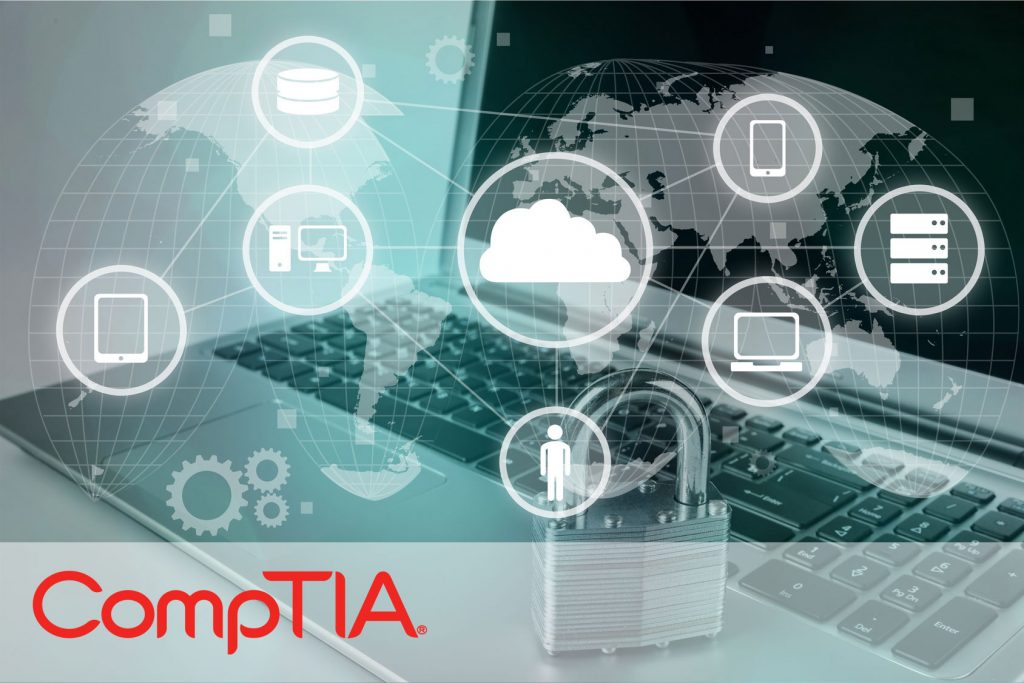CompTIA SY0-501 Security +
CompTIA SY0-501 Security +
CompTIA Security+ not only ensures that candidates will apply knowledge of security concepts, tools, and procedures to react to security incidents, it ensures that security personnel are anticipating security risks and guarding against them. As the demand for IT professionals with Security and Cryptography skills grow, gaining a Security+ certification will distinguish yourself in a fast growing Security and Privacy market.
£149.99
£149.99
Why Choose Us?
- Unlimited lifetime access
- Access anywhere, any time, wherever you have an internet connection
- Fast effective training, written and designed by industry experts
- Track your progress with our Learning Management System
- Unlimited customer and student support
- Save money, time and travel costs
- Learn at your own pace and leisure
- Easier to retain knowledge and revise topics than traditional methods
- Exam preparation quizzes, tests and mock exams to ensure that you are 100% ready
Description
A closer look…
The vendor-neutral certification demonstrates and acknowledge your competency in these areas:
- Network security;
- Compliance and operational security;
- Threats and vulnerabilities;
- Application, data and host security;
- Access control and identity management;
- Cyber attacks;
- Cryptography;
Career & Job Opportunities
CompTIA Authorised Partner. The CompTIA Security+ is a widely recognised and respected qualification in the UK, with an average salary of £52,250pa. The average salary for a Security+ graduate is estimated to be £26,700pa. After graduation, you will easily find work for example as a Junior Security Engineer or Information Assurance Technician. Below is a short list of the range of career opportunities offered to Security+ Professionals:
- Security Architect ;
- Security Engineer;
- Security Consultant/Specialist;
- Information Assurance Technician;
- Security Administrator;
- Systems Administrator;
- Network Administrator;
Modules
| Module 1 | Module 1 | |
| Unit 1 | 01. Introduction to the CompTIA Security+ Exam SY0-501 | |
| Unit 2 | 02. The CIA of Security | |
| Unit 3 | 03. What is Risk | |
| Unit 4 | 04. Threat Actors | |
| Unit 5 | 05. Managing Risk | |
| Unit 6 | 6. Using Guides for Risk Assessment | |
| Unit 7 | 7. Security Controls | |
| Unit 8 | 8. Interesting Security Controls | |
| Unit 9 | 9. Defense in Depth | |
| Unit 10 | 10. IT Security Governance | |
| Unit 11 | 11. Security Policies | |
| Unit 12 | 12. Frameworks | |
| Unit 13 | 13. Quantitative Risk Calculations | |
| Unit 14 | 14. Business Impact Analysis | |
| Unit 15 | 15. Organizing Data | |
| Unit 16 | 16. Security Training | |
| Unit 17 | 17. Third Party Agreements | |
| Module 2 | Module 2 | |
| Unit 1 | 01. Cryptography Basics | |
| Unit 2 | 02. Cryptographic Methods | |
| Unit 3 | 03. Symmetric Cryptosystems | |
| Unit 4 | 04. Symmetric Block Modes | |
| Unit 5 | 05. RSA Cryptosystems | |
| Unit 6 | 06. Diffie-Hellman | |
| Unit 7 | 07. PGP-GPG | |
| Unit 8 | 08. Hashing | |
| Unit 9 | 09. HMAC | |
| Unit 10 | 10. Steganography | |
| Unit 11 | 11. Certificates and Trust | |
| Unit 12 | 12. Public Key Infrastructure | |
| Unit 13 | 13. Cryptographic Attacks | |
| Module 3 | Module 3 | |
| Unit 1 | 01 Identification | |
| Unit 2 | 02 Authorization Concepts | |
| Unit 3 | 03 Access Control List | |
| Unit 4 | 04 Password Security | |
| Unit 5 | 05 Linux File Permissions | |
| Unit 6 | 06 Windows File Permissions | |
| Unit 7 | 07 User Account Management | |
| Unit 8 | 08 AAA | |
| Unit 9 | 09 Authentication Methods | |
| Unit 10 | 10 Single Sign-On | |
| Module 4 | Module 4 | |
| Unit 1 | 01. OS Utilities, Part 1 | |
| Unit 2 | 02. OS Utilities, Part 2 | |
| Unit 3 | 03. Network Scanners | |
| Unit 4 | 04. Protocol Analyzers | |
| Unit 5 | 05. SNMP | |
| Unit 6 | 06. Logs | |
| Module 5 | Module 5 | |
| Unit 1 | 01. Denial of Service | |
| Unit 2 | 02. Host Threats | |
| Unit 3 | 03. Man-in-the-Middle | |
| Unit 4 | 04. System Resiliency | |
| Unit 5 | 05. RAID | |
| Unit 6 | 06. NAS and SAN | |
| Unit 7 | 07. Physical Hardening | |
| Unit 8 | 08. RFI, EMI and ESD | |
| Unit 9 | 09. Host Hardening | |
| Unit 10 | 10. Data and System Security | |
| Unit 11 | 11. Disk Encryption | |
| Unit 12 | 12. Hardware-Firmware Security | |
| Unit 13 | 13. Secure OS Types | |
| Unit 14 | 14. Securing Perpherals | |
| Unit 15 | 15. Malware | |
| Unit 16 | 16. Analyzing Output | |
| Unit 17 | 17. IDS and IPS | |
| Unit 18 | 18. Automation Strategies | |
| Unit 19 | 19. Data Destruction | |
| Module 6 | Module 6 | |
| Unit 1 | 01. LAN Review | |
| Unit 2 | 02. Network Topologies Review | |
| Unit 3 | 03. Network Zone Review | |
| Unit 4 | 04. Network Access Controls | |
| Unit 5 | 05. The Network Firewall | |
| Unit 6 | 06. Proxy Servers | |
| Unit 7 | 07. Honeypots | |
| Unit 8 | 08. Virtual Private Networks | |
| Unit 9 | 09. IPSec | |
| Unit 10 | 10. NIDS-NIPS | |
| Unit 11 | 11. SIEM | |
| Module 7 | Module 7 | |
| Unit 1 | 01. Wireless Review | |
| Unit 2 | 02. Living in Open Networks | |
| Unit 3 | 03. Vulnerabilities with Wireless Access Points | |
| Unit 4 | 04. Cracking 802.11 – WEP | |
| Unit 5 | 05. Cracking 802.11 WPA | |
| Unit 6 | 06. Cracking 802.11 – WPS | |
| Unit 7 | 07. Wireless Hardening | |
| Unit 8 | 08. Wireless Access Points | |
| Unit 9 | 09. Virtualization Basics | |
| Unit 10 | 10 Virtual Security | |
| Unit 11 | 11. Containers | |
| Unit 12 | 12. IaaS | |
| Unit 13 | 13. PaaS | |
| Unit 14 | 14. SaaS | |
| Unit 15 | 15. Deployment Models | |
| Unit 16 | 16. Static Hosts | |
| Unit 17 | 17. Mobile Connectivity | |
| Unit 18 | 18. Deploying Mobile Devices | |
| Unit 19 | 19. Mobile Enforcement | |
| Unit 20 | 20. Mobile Device Management | |
| Unit 21 | 21. Physical Controls | |
| Unit 22 | 22. HVAC | |
| Unit 23 | 23. Fire Suppression | |
| Module 8 | Module 8 | |
| Unit 1 | 01. Secure Applications and Protocols | |
| Unit 2 | 02. Network Models | |
| Unit 3 | 03. Know your Protocols – TCP IP | |
| Unit 4 | 04. Know your Protocols – Applications | |
| Unit 5 | 05. Transport Layer Security (TLS) | |
| Unit 6 | 06. Internet Service Hardening | |
| Unit 7 | 07. Protecting your Servers | |
| Unit 8 | 08. Secure Code Development | |
| Unit 9 | 09. Secure Deployment Concepts | |
| Unit 10 | 10. Code Quality and Testing | |
| Module 9 | Module 9 | |
| Unit 1 | 01. Vulnerability Scanning Tools | |
| Unit 2 | 02. Vulnerability Scanning Assessment | |
| Unit 3 | 03. Social Engineering Attacks | |
| Unit 4 | 04. Social Engineering Attacks | |
| Unit 5 | 05. Attacking Applications | |
| Unit 6 | 06. Attacking Web Sites | |
| Unit 7 | 07. Exploiting a Target | |
| Unit 8 | 08. Vulnerability Impact | |
| Module 10 | Module 10 | |
| Unit 1 | 01. Incident Response | |
| Unit 2 | 02. Digital Forensics | |
| Unit 3 | 03. Contingency Planning | |
| Unit 4 | 04. Backups |





